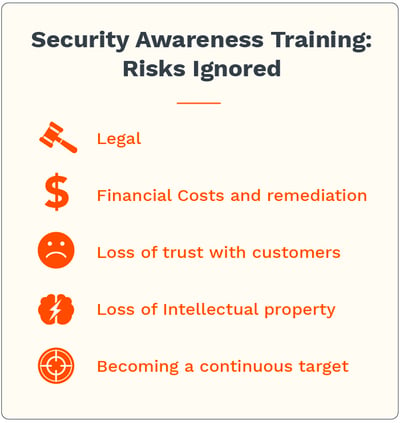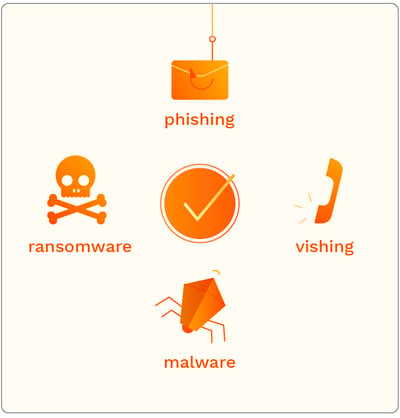A cyberattack can have devastating consequences. Large corporations or even individuals can experience far-reaching consequences and be hit with regulatory fines. As the threat landscape continues to evolve and grow more sophisticated, organizations can benefit from taking a proactive approach to cybersecurity.
In the current threat landscape, malware and ransomware attacks continuously target government agencies, enterprises, and small businesses. Human error remains the leading cause of data breaches and other security events. Thus, enterprises can no longer afford to ignore employee security training.
Practical cybersecurity training involves employee cybersecurity awareness, malware and phishing awareness, and ransomware prevention education. Staff training isn't a one-time endeavor. Instead, it should be a regular component of your corporate culture.
Cybersecurity training can take many forms. For example, companies can start with general cybersecurity awareness training and then narrow it down to topics like social engineering attacks.
Employee Security Awareness Training
Educating your employees is one of the most effective ways to avert potential malware and ransomware attacks. Employee security awareness training is vital to any cybersecurity training program because it helps staff stay alert.

As the threat landscape evolves, keeping pace and training staff frequently is critical. This approach helps keep cybersecurity at the forefront of their minds and helps them stay alert to a potential threat. If you don’t have the necessary resources to conduct a cybersecurity training program, a managed security services provider might be able to help.
How to create an employee security training program
The first step in developing an employee security awareness program is to define the program's key objectives clearly.
Some universal goals of staff security awareness programs are as follows:
- Educating employees on the latest cyber threats and how to defend against them.
- Teaching staff cybersecurity basics like always using strong passwords and multi-factor authentication (MFA), safe web browsing practices, and suspicious email and link recognition.
- Empowering employees to identify and report suspicious activities.
- Building a robust security culture within the organization.
Once you define the program's goals, developing the training materials is next. These materials must be tailored to your organization's and industry's specific needs.
For example, you can share information on the latest cyber threats, cybersecurity best practices, and how to alert security teams to suspicious activity. It helps to create highly interactive and engaging security awareness training materials to keep staff interested and alert.
When you start developing an employee security training program, consider the following best practices:
- Ensuring that your training is engaging and relevant to your employees' roles and responsibilities is important. This can involve using real-world examples and scenarios, and interactive training methods such as quizzes, simulations, and role-playing exercises.
- Making cybersecurity training a regular part of your organization's culture is also vital to mitigate risk and ensure robust security. This can involve scheduling regular training sessions, sending periodic reminders and updates, and encouraging employees to report security incidents or concerns.
- Staying up to date with the latest trends, threats, and tips and updating your training security programs accordingly is crucial. This can involve conducting regular risk assessments, reviewing your organization's security policies and procedures, and staying informed about emerging threats and best practices.
Once training materials are ready, it's time to kickstart your organization's security training program. There are many ways to go about this:
- Classroom training: a workshop with in-person interaction and discussions (can be time and resource intensive).
- Online training: webinars are perfect for hybrid and remote teams who can leverage learning management systems (LMS).
- Gamification: incorporating game elements into the training workshop keeps staff engaged and motivated. For example, employees can earn points, badges, and leaderboards.
Measuring the effectiveness of the security training program
It's critical to continuously measure the effectiveness of your training program to ensure that it works as intended. For example, organizations can measure the effectiveness of cybersecurity training through employee feedback, incident response (compare the number of security incidents before and after the exercise), and phishing simulations.
In the current threat landscape, running simulations and monitoring security events is the most accurate measure of the effectiveness of your cybersecurity awareness program.
What Should You Include in a Cybersecurity Awareness Program?
An effective cybersecurity awareness program will include training workshops covering different cybersecurity threats and how to defend against them.

Phishing Awareness Training
Phishing attacks have been around since the birth of the internet, and they remain highly effective. The primary objective is to send an email or message that will likely trick the recipient into doing what cybercriminals want.
Whenever it works, the recipient reveals sensitive information that can lead to a severe security incident. Sometimes, malware campaigns also attempt to get the recipient to perform an action that enables them to take control of a device or network, detect vulnerabilities, and exploit them.
Phishing works because these malicious communications often appear to be from a trusted source and can be challenging to detect. In fact, with the emergence of sophisticated AI technology like ChatGPT, detecting phishing attacks is now increasingly difficult.
Still, enterprises must engage in phishing awareness training. It's the only way to teach employees to recognize potential social engineering attacks. These workshops can include real-world examples of phishing emails and messages to emphasize the importance of verifying their authenticity.
There are a few techniques that employees can use to identify potentially malicious emails:
Check the Sender's Information
Make it a habit to always check the sender's email address. Do you know this person? Do you know this organization? Does the domain look right? If it's a text message, do you recognize their phone number or handle? If it looks unfamiliar or suspicious, it's probably a phishing attack.
Check the Message Content
Phishing emails and texts often take the form of urgent or alarming messages. When someone demands immediate action (such as clicking on a link or downloading an attachment), staff may not be as alert and open the door to a breach.
Teach employees to always be suspicious of emails that ask for sensitive information. Many social engineering campaigns contain spelling and grammatical errors. However, as AI tools evolve, this will no longer be a key factor in identifying phishing messages.
Verify before Clicking
Before clicking on any links in an email, train employees to hover their mouse over the link to see if the URL matches the displayed text. If it doesn't, it's probably a phishing attempt. Also, encourage them to be wary of shortened URLs, as they hide a link's true destination.
Check for Attachments
Phishing emails and text messages often contain malicious attachments designed to infect devices with malware. In this scenario, employees should not download or open it if they weren't expecting an attachment or if it seems suspicious.
Vishing Awareness Training
Social engineering isn't constrained to email, social media, and chat apps. Threat actors also call employees posing as trusted authorities or colleagues to try and trick them into providing sensitive information. This type of social engineering attack is fairly common and is known as vishing.
To train staff, security teams can conduct random calls pretending to be a member of upper management and ask them to perform some tasks. Or they can pretend to be a member of the security team alerting them to a security breach. In this scenario, the attacker can ask for login details, ask them to download and run remote access software, or lead them to a fake website and ask them to log in.
This type of training can be a fun exercise for all involved and a learning experience employees won't easily forget.
Malware Awareness Training
Malware is essentially software that is designed to damage or exploit enterprise systems. Malware takes many different forms, including viruses, worms, and trojans, and can infect a device (and then networks) through email attachments, malicious websites, or external devices like USBs.
For example, malware awareness training should focus on educating employees on identifying them. Malware infections can be identified by being alert to pop-up ads, slow computer performance, and unauthorized file access.
Staff security training should include various ways to prevent malware infections. For example, employees can help mitigate risk by keeping their software up to date (especially next-gen antivirus software and antimalware programs), avoiding suspicious downloads, and not clicking on unknown (suspicious) links. In this scenario, it's always best to ask staff to trust no one.
Ransomware Awareness Training
Ransomware is also a type of malware. The hacker's aim is to encrypt a victim's files and demand a ransom payment. Whenever the payment is made, the organization receives a decryption key (but not always).
With the rise of cryptocurrencies like Bitcoin and Ethereum, ransomware attacks are rampant and often devastating. Whenever an organization falls victim to a cyberattack, it can result in the loss of critical data, brand value, and significant downtime.
Ransomware prevention training should focus on educating employees on how to avoid ransomware infections. Again, ransomware training must focus on mitigating the risk of a ransomware threat.
It should encourage staff to regularly backup their data. This approach can help optimize enterprise incident response protocols.
It's also crucial to emphasize the importance of reporting any suspicious activity or security incidents to in-house security professionals.
Cyber threats are relentless in today's threat landscape; everyone is a live target. Vigilance is critical to any effective cybersecurity strategy and should be the emphasis of employee training. It's a key component of mitigating the risk of malware and ransomware incidents.
Categories: Security, Culture, Strategy, Cyber Security, Malware, IT Management, Network Security, Proactive Network Security, Security Breach, Managed Security Services, IT Security, Phishing, Email Security, IT, Cybersecurity, Employee Training











